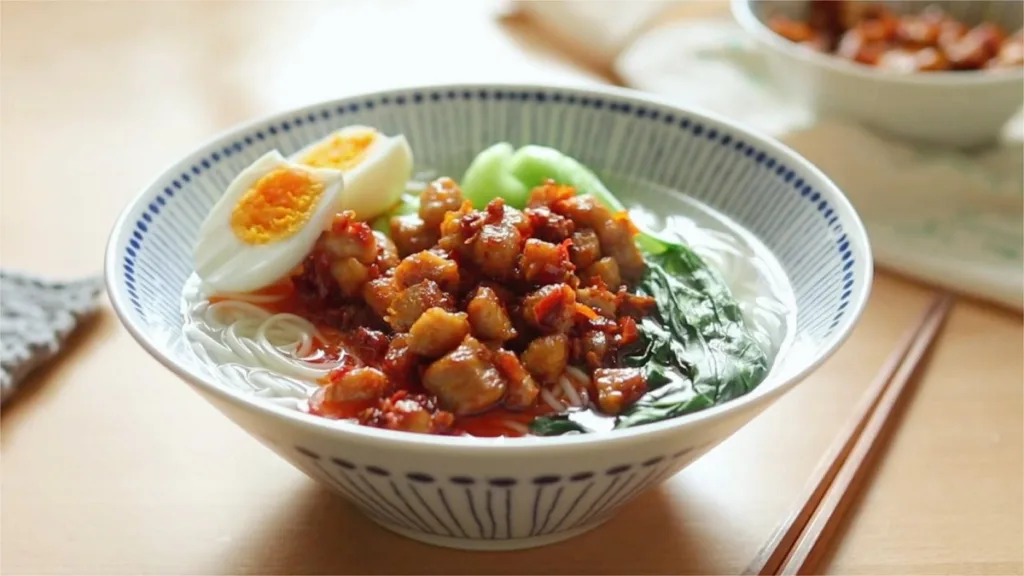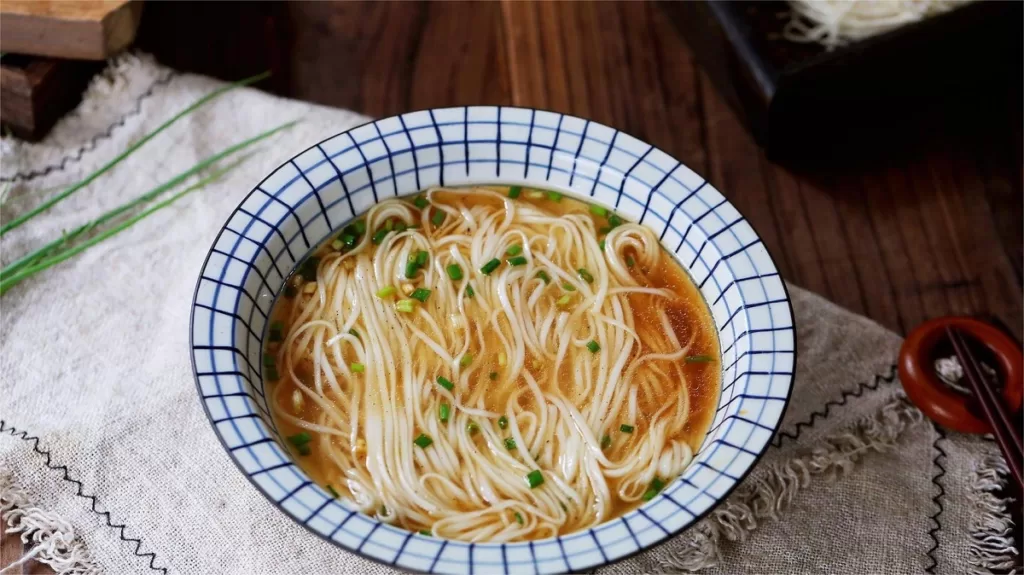Shanghai, a bustling metropolis known for its rich cultural tapestry and dynamic culinary scene, offers a myriad of gastronomic delights that reflect its storied history and vibrant lifestyle. Among these, Shanghai-style noodles hold a special place, capturing the essence of the city’s diverse influences and flavors. Each noodle dish tells a unique story through its ingredients and preparation methods, offering a taste of tradition and innovation. From the fiery punch of Spicy Pork Noodles to the refined simplicity of Plain Noodles in Broth, these iconic dishes are not only a staple in the local diet but also a culinary experience that embodies the soul of Shanghai.
1. Spicy Pork Noodles (辣肉面)

Description and Preparation: Spicy Pork Noodles are a beloved Shanghai specialty, renowned for their unique spicy flavor and succulent pork. The key to this dish lies in the preparation of the spicy pork topping. Fresh pork is sliced into thin strips or small chunks, marinated with a blend of spices, and then stir-fried until fully flavored. The amount of chili can be adjusted according to personal preference, but it typically has a noticeable spiciness that enhances the noodles’ flavor.
The noodles used are thin and chewy, cooked to perfection before being mixed with the spicy pork topping. The dish is finished with a generous drizzle of chili oil, which gives it a vibrant red color and an enticing aroma. Often accompanied by tofu or “vegetarian chicken” (素鸡), which absorbs the rich, spicy sauce without becoming greasy. The quick preparation of the spicy pork topping means the dish can be served rapidly, making it a popular choice for both locals and visitors.
Characteristics:
- Spicy and flavorful pork
- Chewy noodles
- Quick preparation
- Vibrant chili oil garnish
2. Plain Noodles in Broth (阳春面)

Description and Preparation: Plain Noodles in Broth, also known as Yangchun Noodles, is a traditional noodle dish from the Jiangnan region, of which Shanghai is a part. Known for its clear, flavorful broth and light taste, this dish is a perfect example of simplicity and elegance in Shanghai cuisine.
The broth is typically made from a base of pork bones and chicken bones, simmered for hours to extract a deep, rich flavor. After the broth is prepared, it is seasoned with salt and a touch of MSG to enhance its umami. The noodles, thin and elastic, are cooked until just tender and then placed in a bowl. Hot broth is poured over the noodles, and the dish is garnished with chopped scallions and a small amount of lard for added richness. This results in a comforting bowl of noodles with a clean, savory taste.
Characteristics:
- Clear and flavorful broth
- Light and refreshing
- Thin, tender noodles
- Simple yet satisfying
3. Scallion Oil Noodles (葱油拌面)

Description and Preparation: Scallion Oil Noodles are a classic Shanghai noodle dish celebrated for its fragrant scallion oil and smooth noodles. The preparation of scallion oil is crucial to this dish. Fresh scallions are chopped and simmered in either lard or vegetable oil until they become golden brown and aromatic, releasing a rich, savory aroma that is the hallmark of this dish.
The noodles are thin and springy, cooked until they reach the perfect texture. After cooking, they are rinsed in cold water to remove excess starch, which helps them remain firm and chewy. The prepared scallion oil is then mixed with the noodles, along with salt and MSG to taste. For an extra touch, some diners like to add small dried shrimp (开洋) for additional umami flavor. The result is a dish that is simple yet bursting with the robust flavor of scallion-infused oil.
Characteristics:
- Fragrant scallion oil
- Smooth, chewy noodles
- Simple seasoning
- Optional dried shrimp for extra flavor
4. Braised Intestine Noodles (大肠面)

Description and Preparation: Braised Intestine Noodles are a unique Shanghai dish known for their rich and savory flavor, derived from the use of pork intestines as a topping. There are two main types of intestines used: the tender and crunchy tips of the intestine and the more robust and chewy straight sections.
Preparing the intestines involves meticulous cleaning and marinating with salt and cooking wine to remove any off-flavors. After cleaning, they are boiled and then sliced into pieces. The intestines are then braised in a flavorful sauce until they become tender and soak up the rich broth. The noodles, thin and elastic, are cooked and then combined with the braised intestines and broth.
Characteristics:
- Rich and savory braised intestines
- Thin, chewy noodles
- Flavorful broth
- Textural contrast between tender and chewy intestines
5. Yellow Croaker Noodles (黄鱼面)

Description and Preparation: Yellow Croaker Noodles feature yellow croaker, a fish known for its tender, delicate flesh, as the main ingredient. The fish is prized not only for its flavor but also for its nutritional value, being rich in high-quality protein and essential fatty acids.
To prepare this dish, the yellow croaker is cleaned and either sliced into fillets or cut into chunks. The fish is cooked together with the noodles in a pot of boiling water. Once the noodles and fish are cooked, they are served in a bowl with a light broth made from the fish bones, seasoned with salt and MSG to enhance the natural sweetness of the fish. The result is a bowl of noodles that is both delicious and nutritious, with the tender fish complementing the springy noodles and the light, savory broth.
Characteristics:
- Tender and delicate fish
- Nutrient-rich and flavorful
- Light and savory broth
- Thin, chewy noodles
Each of these noodle dishes offers a distinct taste of Shanghai’s culinary traditions, showcasing the city’s ability to transform simple ingredients into flavorful, satisfying meals. From the spicy kick of Spicy Pork Noodles to the delicate flavors of Yellow Croaker Noodles, these dishes are a testament to the richness and diversity of Shanghai cuisine.

